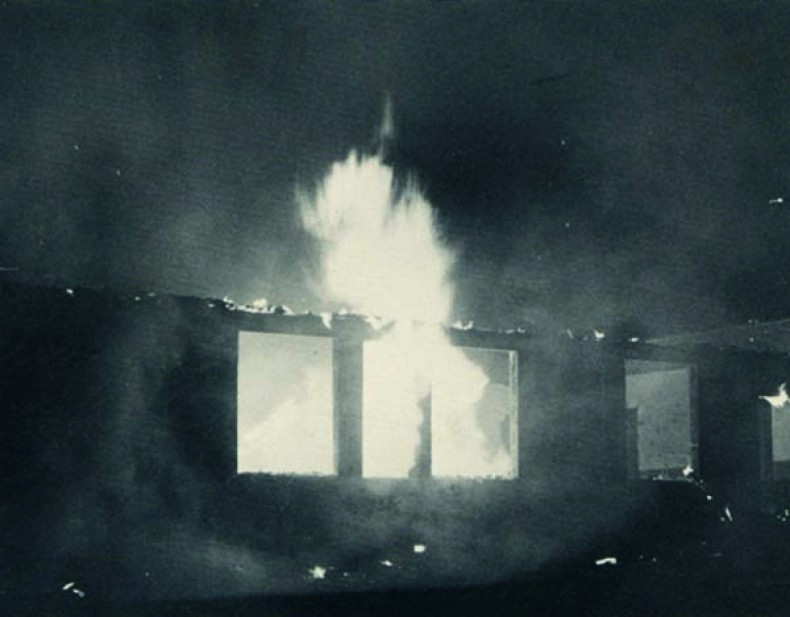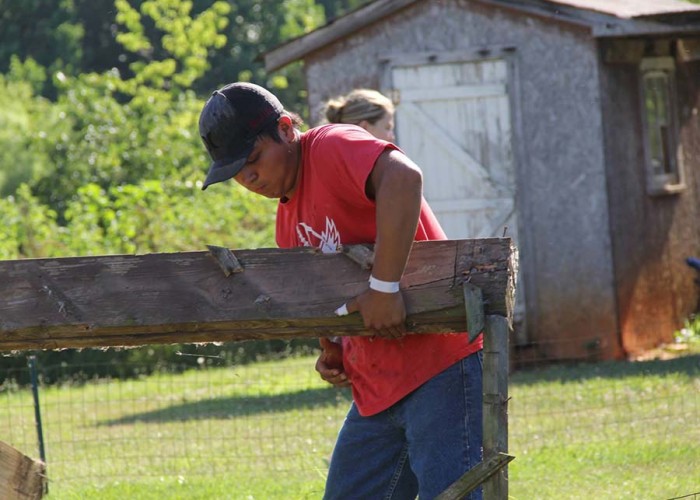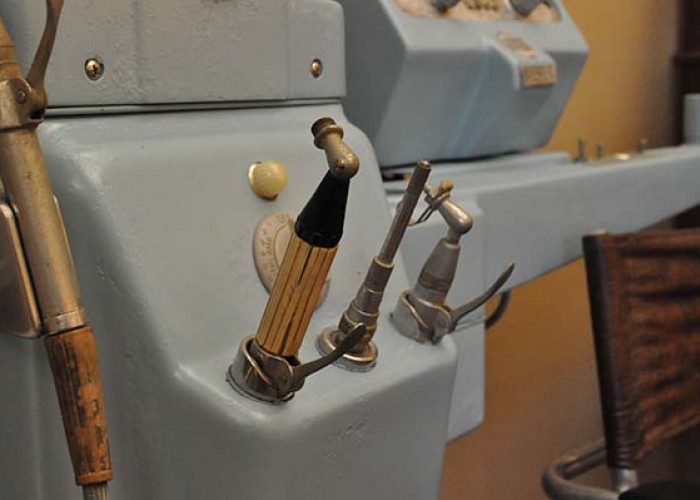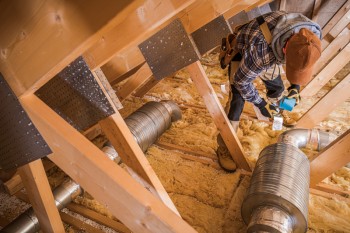The East Bend School Fire
The Yadkin County community of East Bend learned some lessons after the beloved school burned down
By Sandra Miller
Click on the photo to view slideshow.
The reunion at a local restaurant last September brought members of the 1964 graduating class of East Bend High School together to reminisce about an eventful year they shared 50 years ago—the year the school burned down in April.
The school year began as any other in September of 1963, but students were soon to be shaken up at the announcement that President Kennedy had been assassinated on November 22. I was in my freshman PE class when the principal made the announcement on the intercom. Jumping jacks came to a screeching halt, and all of us girls froze in place. An eerie presence swept through our small-town school that day, and a somber reserve latched onto each of us. Assassinations of public officials were something we read about in history books, not something we expected to experience firsthand. But kids have a way of adjusting to things they cannot understand.
None of us, though, were ready for the change that awaited us come spring. Small schools in small towns have small classes and tight-knit groups. We had been together since first grade. Students from Fall Creek and Forbush elementary schools moved to East Bend in the 9th grade. High school was a big deal, but we adapted. Our class totaled around 60 students. And we blended like berries in a cobbler.
High school meant we could participate in sports and new school activities. Other than church functions, school activities were all many of us had to look forward to. So awaking to the news on April 8, 1964, that our school had burned to the ground during the night was earth shattering. Students and teachers alike were shaken to the core. I recall the sickening feeling that washed over me when I saw the ruins. All of the elementary section — 16 stately classrooms, where both my parents and I were schooled our first eight years — was gone, along with the auditorium, administrative office, and an older section of the high school. All that remained standing was the high school library, science lab, home economics room, cafeteria, agriculture building, and gymnasium, along with one mobile unit. School records dating back to the 1920s were destroyed.
The fire was discovered around 3:30 a.m., when flames roared through the roof and lit up the sky. Clyde Lane, a nearby resident, ran over to the adjacent firehouse and pulled the siren. It was reported that the flames could be seen 20 miles away in Winston-Salem. Twelve fire departments from surrounding counties joined East Bend’s firemen in an effort to put out the blaze. They fought fearlessly, but the flames raged with unbridled fervor, and within a four-hour span the structure that had been the center of the community since 1923, and added to in 1935, was destroyed.
Transformation
For so many years the well-kept lawn and towering longleaf pines in front of the school complemented the building’s aged, dark red bricks. Faculty and students for so many years respected those grounds. It was home while we were away from home, a safe haven for kids. While plans were drawn to replace what was lost, we knew that asphalt and cement could not compensate for what nature had provided. Many of the trees had been charred. Modern architecture could not bring forth the trust and pride that grew through the years as students paced up and down those frequently oiled hardwood floors.
The gymnasium that survived had replaced one that was torn down in 1959. Coach Jim Morgan taught us the importance of caring for the hallowed gym floor. Yadkin County schools were especially competitive in basketball, and our gym was a reflection of that. Students were not allowed to step on the shiny gym floor with street shoes, and we participated in its upkeep. So as work began to build partitions in the gym that would be makeshift classrooms, many of us watching felt a heart-nudge with each nail they hammered into the gym floor.
It was Thomas Wooten’s first year as principal. The position took on new meaning as he and Yadkin’s Board of Education gathered around the decision-making table. An East Bend graduate himself, Mr. Wooten remembers the scene with vivid detail. “When they called to tell me it was burning,” he said, “I went down and, you know how it feels when the bottom of something falls out?” (I remembered well the feeling he described.) “Well, that’s the way I felt,” he said. “I looked and couldn’t believe it, didn’t want to believe it. All we had to be thankful for was that nobody was in it.”
The fire was on a Wednesday and we were back in school the next Monday. The mobile units in use were insufficient to accommodate both the elementary grades and high school. Wooten laughs when he recalls that his wife, Mary, moved her 2nd and 3rd grade combined class into the girls locker room in the gym. “It was the only classroom that had a bathroom in it!” He also reminded me that even the cafeteria was transformed into classrooms. At lunchtime, he let the high school students carry their trays outside.
Close quarters
Today, you might assume that our school situation would been an ideal opportunity for crime. But thankfully, we lived in a different world. If anything, we became more protective of the remains of our alma mater, and of each other. After school each day, the basketball teams boarded the one activity bus we had, and we were hauled to Fall Creek Elementary for practice. I can still remember the smell of old lunch in their gym—the gym was also their lunchroom. But we were grateful for the hospitality and a place to practice. We played our games up the road at Boonville High School, when their games were away.
Even though we shared a sense of loss, we found some fun. The close partitions in the gym “classrooms” allowed us to throw spit wads back and forth over the walls when the teachers weren’t looking. Even with all the noise, we somehow managed to make out what our teachers were saying in class. But if you chose to, you could easily lose yourself in the class next door. And there was little separation between the high school students and the smaller kids. Mr. Wooten recapped a story I remember about the two high school English classes side-by-side in the library. “Mr. Barnes was giving a test on the same subject that Mrs. Bensing was lecturing on,” Wooten recalls. “So he asked her to stop teaching until his test was over.”
The business classes shared the Ag building with the shop students, which meant the boys couldn’t use saws and such while the other classes were going on.
Mr.Wooten reminded me that the fire destroyed the newly purchased intercom system. So we changed classes when he walked the halls and blew a whistle. He and Mrs. Doub, the school secretary, performed their administrative duties from the small concession stand in the gym.
“Everyone pulled together,” Mr. Wooten said.
Area churches offered use of their buildings, but “we buckled down and decided we could make do.” WTOB radio station in Winston-Salem volunteered airtime for announcements. The handmade bricks from the destroyed building were sold for a dollar a brick. Government grants helped replace some essentials, and the Western Electric Company in Winston-Salem loaned typewriters. Our own candy and magazine sales campaigns contributed. One man who purchased some magazines said that he wouldn’t read them, but he’d buy some to help, and to use as kindling.
Moving on
When graduation rolled around, they set up bleachers for the ceremony outside in front of the rubble, and we prayed that it wouldn’t rain. The school chorus, directed by Mr. Norm Barnes, performed. “It was very moving,” recalls Mr. Wooten. “It was the prettiest graduation I’ve ever attended. Just as I pronounced them graduates, the sun set.”
The class of 1964 moved on. The rest of us were let out for summer vacation, hoping that a new school year would unravel the chaos. But as fate would have it, the new building project was too large to complete by fall. Finally, in January of 1965, volunteer carpenters from around the community came with saws and hammers and began tearing down the “classroom” partitions in the gym. Mr. Wooten said that coach Morgan immediately started dribbling a basketball on the gym floor and determined that they did a good job of removing the partitions. There weren’t enough splinters to make much difference. So practice began again on home turf. “It was a happy time for the kids when the partitions came up,” Mr. Wooten said. “It took maybe two hours to move into the new section.” Students carried desks and books to the new locations, while the “Ag boys” ripped out partitions in the other areas.
Three years after the fire destroyed our school building, my class of 1967 was East Bend’s last high school graduating class. That was the year when schools were consolidated in the county, and East Bend would become an elementary school. On June 1, 1967, we graduated from an era that would never return. We walked away from more than a high school — we left a way of life. We would never again meet each morning for devotions in our homerooms. The Glee Club would never travel together to sing at revival meetings and community functions. Our competitive spirits would never unite in victories and defeats.
Adjusting to life without the comrades we’d had for most of our childhoods was not easy for some of us, but all of us learned the lesson of pulling together when we needed to. Debbie Davis, a sophomore in 1964, and Carol Minton, a freshman, went house to house selling candy and magazines to earn money for rebuilding the school. Debbie Davis Gough eventually became principal of East Bend Elementary. After college, my classmate Carol Minton returned to Yadkin County to begin its first kindergarten program and taught in that position until she retired.
The two new high schools, Forbush and Starmount, ushered in a new period of learning and competing. But those of us who grew and learned during simpler times carried with us irreplaceable life lessons. We may not have benefitted from the technology that awaited the new high schools, but we had our discipline and camaraderie. We learned the lesson of pulling together when we needed to.
About the Author
Sandra Miller, who was a freshman at East Bend High School in 1964, is a freelance writer in Yadkin County and author of "When Mountains Move," a memoir.-
Read More on Yadkin County by Sandra Miller
-
Share this story:


















Comments (5)
NurseMabe |
March 26, 2015 |
reply
Now I sit here with my iPad (Who would have dreamed) recalling some of the best days of my life and the great kids that shared them, it’s like opening an old favorite book. Each page leads to another and brings back a memory that leads to another memory. It was great time. Thanks for reminding me...Hi to Jerry....Jack
steel post
Jackie Patterson |
March 27, 2015 |
reply
Steve Binkley |
March 27, 2016 |
reply
David K Hobson |
March 28, 2016 |
reply
deana doub |
June 24, 2018 |
reply